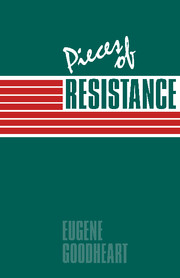Book contents
- Frontmatter
- Contents
- Preface
- Acknowledgments
- Autobiographical
- Part I Critics and criticism
- Part II Contemporary culture in conflict
- Part III Writing in America and elsewhere
- 13 The New Country: Stories from the Yiddish About Life in America
- 14 Three Novels, by Daniel Fuchs
- 15 The demonic charm of Bashevis Singer
- 16 The thirties revisited: Meyer Liben's Justice Hunger and Nine Stories
- 17 Bernard Malamud's A New Life
- 18 Ralph Ellison's Shadow and Act
- 19 William Styron's The Confessions of Nat Turner
- 20 Donald Barthelme's The Dead Father
- 21 Raymond Carver's Cathedral
- 22 Saul Bellow's Him with His Foot in His Mouth and Other Stories
- 23 The claustral world of Nadine Gordimer
19 - William Styron's The Confessions of Nat Turner
Published online by Cambridge University Press: 05 August 2012
- Frontmatter
- Contents
- Preface
- Acknowledgments
- Autobiographical
- Part I Critics and criticism
- Part II Contemporary culture in conflict
- Part III Writing in America and elsewhere
- 13 The New Country: Stories from the Yiddish About Life in America
- 14 Three Novels, by Daniel Fuchs
- 15 The demonic charm of Bashevis Singer
- 16 The thirties revisited: Meyer Liben's Justice Hunger and Nine Stories
- 17 Bernard Malamud's A New Life
- 18 Ralph Ellison's Shadow and Act
- 19 William Styron's The Confessions of Nat Turner
- 20 Donald Barthelme's The Dead Father
- 21 Raymond Carver's Cathedral
- 22 Saul Bellow's Him with His Foot in His Mouth and Other Stories
- 23 The claustral world of Nadine Gordimer
Summary
We are within the consciousness of Nat Turner as the events of his life, the slave system of the ante-bellum south and the extraordinary rebellion that he led are narrated and described. But what does it mean to say that we are inside Nat Turner's consciousness? And who is Nat Turner anyway? William Styron has been praised for his capacity to get inside a black man's consciousness. But the black man is Styron's own creation. Styron himself tells us in a prefatory note that “there is little knowledge in regard to Nat,” and that he has allowed himself “the utmost freedom of imagination in reconstructing events.” It is highly doubtful that Styron's Nat has very much to do with the historical Nat Turner, who according to Styron, led the only effective revolt before the Civil War. Herbert Aptheker, who has written an historical account of the events, is appalled by the liberties Styron has taken. (He also claims that there were other effective revolts.) For him Styron's “freedom of imagination” amounts to a monstrous historical distortion. I do not want to enter into the tangled controversy about Styron's historical accuracy, nor into the related question of the novelist's obligation to historical fact in his “meditation on history,” but the praise for Styron's empathy with the Negro consciousness, it seems to me, has been unconsidered. It has deflected critical discussion from the interesting problematic character of the book.
- Type
- Chapter
- Information
- Pieces of Resistance , pp. 153 - 157Publisher: Cambridge University PressPrint publication year: 1987



